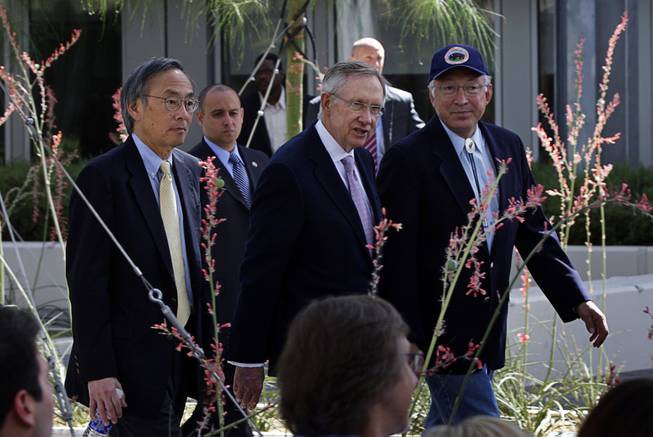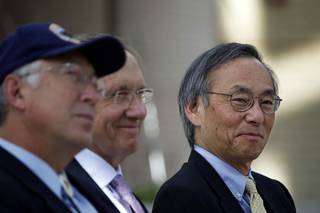
Secretary of Energy Steven Chu, left, Senate Majority Leader Harry Reid (D-Nev.), center, and Secretary of Interior Ken Salazar arrive to announce a Nevada Test Site solar power development zone during a news conference at UNLV on July 8, 2010.
Friday, July 9, 2010 | 2:01 a.m.
Economic bonanza
A plan to build a lab to test new solar power technologies on part of the Nevada Test Site was cheered by solar developers. It is expected to create 1,000 construction and electrical jobs as well as long-term jobs in maintenance, engineering and research.
Sun archives
In the 1950s, the Nevada Test Site provided the evidence that U.S. nuclear capability was far ahead of the rest of the world’s. The federal reservation 65 miles northwest of Las Vegas is now tasked with making the nation the global leader in solar power.
Thursday’s announcement that a wide swath of the Test Site will be the proving ground for new solar technologies was hailed by federal officials, renewable energy researchers and solar developers with Nevada ties.
The plan includes building a real-world laboratory for emerging concentrating solar power technologies on 25 square miles of the Test Site. Officials said it would most likely focus on concentrating solar thermal power breakthroughs.
Senate Majority Leader Harry Reid, who led efforts to get the testing ground established in Nevada, said it would foster the next generation of solar energy technologies and provide jobs for everyone from construction workers to engineers to academics.
“It’s hard to imagine a better place to capture the heat from the sun than right here,” Reid said, noting Nevada’s 300-plus sunny days a year.
Concentrating solar thermal technology takes the sun’s rays and uses mirrors to focus them onto a tube or tower filled with liquid, often water or a brine solution. The heat from the sun brings that liquid to a boil, creating steam that turns a turbine. These facilities require thousands of flat, sunny acres, but they also often need large amounts of water for cooling towers.
Some concentrating solar thermal power plants planned for Nevada and Arizona include large silos where the molten liquid can be stored into the night and used for electric generation later.
New technologies will likely focus on improving those heat storage capacities, reducing water consumption and improving efficiency, experts said.
Energy Secretary Steven Chu, who joined Reid in the solar panel-covered patio of UNLV’s Greenspun Hall for the Test Site announcement, said the new facility will be key in taking heretofore theoretical technologies developed in universities and private companies and bringing them to market. Breakthroughs that have come to market have been either tested overseas or are limited to a few solar thermal and photovoltaic technologies run through government-testing programs at the National Renewable Energy Laboratory.
The facility planned for the Test Site would open up testing to technologies that need more space and more time to assess. It will likely have anywhere from four to six test projects at a time, said Interior Secretary Ken Salazar, who was also at the news conference.
“This testing ground for solar technology won’t involve the generation being deployed today,” Chu said. “This will be testing for the next generation that will continue to drive the price of solar energy down.”
That is key to President Barack Obama’s plan to transition the country away from polluting energy sources such as coal and oil to cleaner renewable energy. Wholesale renewable energy can cost up to three times as much per kilowatt-hour as fossil fuel power, and solar is the most expensive. But as technology improves and the price drops, utilities can deploy more renewable energy power plants while keeping retail electricity prices stable. This would allow the country to phase out more polluting power sources without impeding economic growth, experts said.
Representatives and CEOs from most of the major Nevada-affiliated solar developers — Bombard Renewable Energy, Solar Millennium, First Solar/NextLight, BrightSource Energy and NV Energy — attended the event.
Most agreed the study area would allow game-changing technologies to come to market much faster and could give the United States an edge in the global market.
The U.S. invented most of the major renewable energy technologies in use around the world today. But many systems were market-tested and eventually manufactured overseas. Energy experts said a study area such as the one planned for the Test Site could allow more American technologies to be tested and built in America.
“Here in Nevada, we’ll be able to demonstrate to the world that renewable energy can power the future,” Salazar said.
Construction is expected to start in 2011 and bring thousands of badly needed short- and long-term jobs to Nevada, Reid said. Those will include about 1,000 construction and electrical jobs to build the test projects, but also longer-term jobs in maintenance, engineering and research.
Referring to Nevada’s dubious distinction as the state with the worst rates of unemployment and home foreclosures, Reid urged the diversification of the state’s economy through increased renewable energy development.
“The best way to create jobs is to make Nevada the leader in something else: new, clean energy jobs,” he said.
The solar test area might not have happened in Nevada at all, the delegation from Washington stressed, had it not been for Reid.
“Without his support, this would not have been funded and would not be here in Nevada,” Salazar said.
Reid has made renewable energy a major platform in his bid for re-election and has had his hands in numerous renewable energy industry achievements for the state, including the federal fast-tracking program for renewable energy developments to convincing a Chinese wind turbine manufacturer to set up shop in Las Vegas.
His opponent, Republican Sharron Angle, has not revealed her formal position on renewable energy nor returned calls seeking interviews on the topic.


Join the Discussion:
Check this out for a full explanation of our conversion to the LiveFyre commenting system and instructions on how to sign up for an account.
Full comments policy